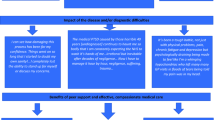A hidden disability is a physical medical condition that is unapparent to the unknowing observer. The following essays explore the identity processes of two young women with the hidden disabilities juvenile rheumatoid arthritis and celiac disease. These stories were obtained using a narrative research methodology. In the data representation, vivid narrative depiction is used to understand how culture, religion, gender, and accepted social norms influence adaptation and integration of a hidden disability into one’s personal identity.
Access this chapter
Tax calculation will be finalised at checkout
Purchases are for personal use only
Preview
Unable to display preview. Download preview PDF.
Similar content being viewed by others
References
Barone, T. (2000). Aesthetics, Politics, and Educational Inquiry: Essays and Examples. New York, NY: Peter Lang.
Barone, T., & Eisner, E. (1997). Arts-based educational research. In R. M. Jaeger (Ed.), Complementary Methods for Research in Education, 2nd ed. (pp. 75–116). Washington, DC: American Educational Research Association.
Charon, R. (1993). The narrative road to empathy. In H. M. Spiro (Ed.), Empathy and the Practice of Medicine: Beyond Pills and the Scalpel (pp. 147–159). New Haven, CT: Yale University Press.
Clandinin, D. J., & Connelly, F. M. (2000). Narrative Inquiry. San Francisco, CA: Jossey-Bass.
Coulter, D. (1999). The epic and the novel: Dialogism and teacher research. Educational Researcher 28, 4–13.
Darling, R. B. (2003). Toward a model of changing disability identities: A proposed typology and research agenda. Disability & Society 18, 881–895.
Docherty, D., & McColl, M. A. (2003). Illness stories: Themes emerging through narrative. Social Work in Health Care 37, 19–39.
Gibran, K. (1923). The Prophet. New York, NY: Alfred A. Knopf, Inc.
hooks, b. (1994). Narratives of struggle. In P. Mariani (Ed.), Critical Fictions: The Politics of Imaginative Writing (pp. 53–61). Seattle, WA: Bay Press.
Lieblich, A., Tuval-Mashiach, R., & Zilber, T. (1998). Narrative Research: Reading, Analysis, and Interpretation. London: Sage.
Polkinghorne, D. (1991). Narrative and self-concept. Journal of Narrative and Life History 1, 135–154.
Polkinghorne, D. (1995). Narrative configuration as qualitative analysis. In J. Hatch & R. Wisniewski (Eds.), Life History and Narrative (pp. 5–25). London: Falmer Press.
Riessman, C. K. (2003). Performing identities in illness narrative: Masculinity and multiple sclerosis. Qualitative Research 3, 5–33.
Saleebey, D. (2006). The strengths perspective: Possibilities and problems. In D. Saleebey (Ed.), The Strengths Perspective in Social Work Practice, 4th ed. (pp. 279–301). Boston, MA: Allyn & Bacon.
Scott-Hill, M. (2004). Impairment, difference and ‘identity’. In J. Swain, S. French, C. Barnes, & C. Thomas (Eds.), Disabling Barriers — Enabling Environments (pp. 87–93). London: Sage .
Siebers, T. (2004). Disability as masquerade. Literature & Medicine 23, 1–22.
Somers, M. (1994). The narrative construction of identity: A relational and network approach. Theory and Society 23, 605–649.
Thomas, C. (1999). Narrative identity and the disabled self. In M. Corker & S. French (Eds.), Disability Discourse (pp. 47–56). Philadelphia, PA: Open University Press.
Woodward, K. (2002). Understanding Identity. London: Arnold.
Editor information
Copyright information
© 2011 Darla Schumm and Michael Stoltzfus
About this chapter
Cite this chapter
Valeras, A. (2011). God’s Will? How Two Young Latina Catholic Women Negotiate a Hidden Disability Identity. In: Schumm, D., Stoltzfus, M. (eds) Disability and Religious Diversity. Palgrave Macmillan, New York. https://doi.org/10.1057/9780230339484_1
Download citation
DOI: https://doi.org/10.1057/9780230339484_1
Publisher Name: Palgrave Macmillan, New York
Print ISBN: 978-1-349-29832-7
Online ISBN: 978-0-230-33948-4
eBook Packages: Palgrave Religion & Philosophy CollectionPhilosophy and Religion (R0)




